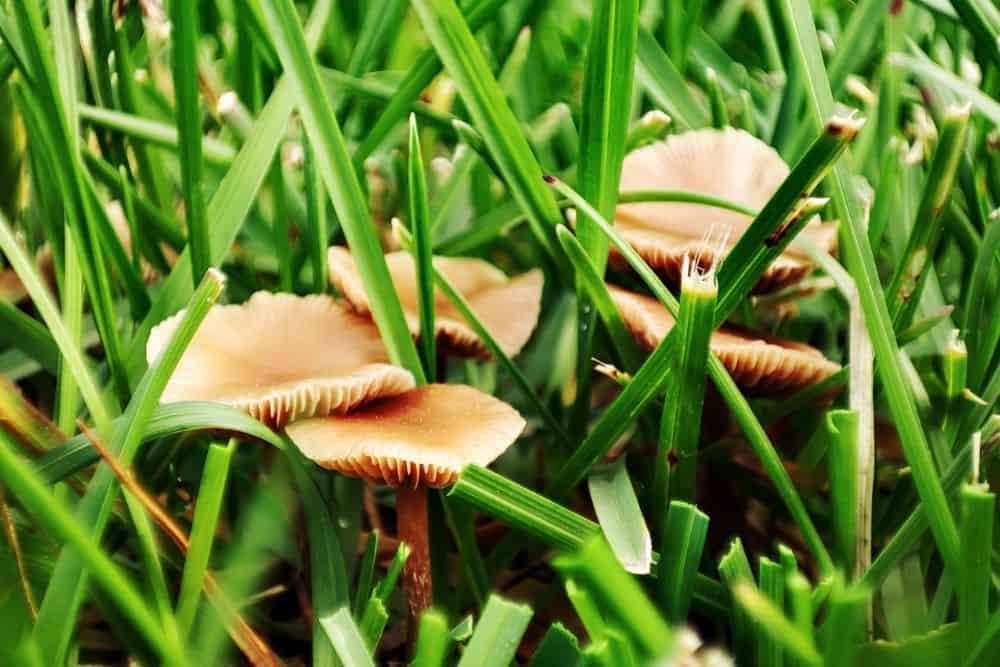8 Ways How To Get Rid Of Mushrooms In Lawns And Gardens
Mushrooms may partly disrupt the appearance of your lawn and garden. There’s so much green space yet a mushroom can ruin the overall view. However, they do some good. Mushrooms help retain moisture and break down organic matter. That process actually helps nutrients get into the grass and soil below. Though they do look unsightly.
Once, or even several times a year, you find yourself on your hands and knees removing those mushrooms. What if you were only treating the symptoms of their reoccurrence? What if you thought you’d gotten rid of them once and for all? Yet those mushrooms just keep coming back. Not ideal if your house is ready for the real estate market. Nor if they could be poisonous to adults, children, and pets.
You need to find out the underlying causes of why these mushrooms keep appearing. Once you’ve found the right methods those mushrooms will be gone from your lawn and garden. There are several ways you can try and we’ll help you find the right one.
Why Do Mushrooms Keep Reappearing In Your Lawn And Garden?
The sight of a mushroom is usually a warning sign. They seem to sprout up out of nowhere yet they are the tangible result of a problem that lies underground. Namely that you have a fungus lying deep in the soil. A fungus that is thriving and those mushrooms in your lawn and garden are the proof.
Think of those mushrooms as the fruiting bodies of that fungi. Given time and the right conditions, they will develop then produce and spread their spores.
The underground rooting system is known as mycelia and can grow up to half a mile. That’s each day. Worrying isn’t it.
There may be fundamental reasons for the presence of mushrooms that can be directly attributed to your lawn and garden. That’s not to suggest that your lawn and garden are unhealthy. Far from it. Mushrooms cannot grow in nutrient-deprived soil. They even help your lawn and garden.
As they grow, mushrooms actively recycle and break down organic matter to benefit your soil with even more nutrients.
Yes, that organic matter. One reason for the mushrooms could be an excessive amount of decaying organic matter in your lawn and garden. Mushrooms break that down and without it, they’d struggle to thrive. Without organic matter, the mushrooms shouldn’t be there. This can include animal waste, twigs, grass clippings, fallen leaves, and mulch that’s been left over time.
Look at your lawn and garden. Are the mushrooms concentrated in a specific area or running the entire length of the lawn? If there are specific areas where mushrooms grow, try to work out why those areas are different.
Ideal conditions for mushrooms include areas with a lack of sunlight and lots of organic matter to feed on. If there’s a healthy source of moisture then that’s great for mushrooms too.
If that specific area of your garden is shaded and damp then mushrooms may well thrive there. Poor maintenance of your garden could likely mean that organic matter is allowed to pile up too.
There could also be a drainage problem with your lawn. That could be down to a clay profile in your soil that needs addressing. Applying liquid solutions won’t solve the problem of the mushrooms growing if the conditions they thrive in are still there.
Tools And Equipment
You’ll need a few items to deal with your mushrooms. These include;
- A plastic bag – To remove mushrooms
- Pruning scissors – To trim branches from any tree that’s shading your lawn or garden
- A rake – To remove any debris from your lawn
- An aerator – To help aerate your lawn
- A screwdriver/dibber – To produce deep, small holes in your lawn or garden
- Dish soap – Just one of several ingredients to try in different solutions
- A funnel – To disperse a dish soap solution into those holes
- A spray bottle – To disperse easy-to-make solutions
- A bucket – To mix liquid solutions
- White vinegar – Another active ingredient for a simple solution to try
- Horticultural vinegar – A more potent form of vinegar to use in the garden
- Garden gloves – To protect yourself from horticultural vinegar
- Eye protection – See above
- Baking soda – Yet another active ingredient
- Nitrogen fertilizer – To help remove any organic matter before mushrooms feast on it
Now that you’ve got the equipment, get rid of the mushrooms that are already there.
Firstly, those mushrooms that have already sprouted can be removed. You can pick them by hand while wearing garden gloves. Pluck them out from the base as soon as they pop up. Don’t wait until there’s a cluster. You want to ensure the spores cannot disperse and then create even more mushrooms.
Removing any prevalent mushrooms before mowing is also a worthwhile exercise. Don’t throw them back into the compost as they will regrow by feasting on all that organic matter. They’ll also manage to spread their spores over the area too. Instead, put the mushrooms into the trash and make sure it’s sealed tightly.
Certain ways to get rid of mushrooms involve making changes to your lawn and garden.

Get Some Sunlight In
If your lawn and garden have shaded areas where mushrooms grow, bring some more light in. Simple really, clear the area of any mulch or organic matter. During a good sunny day try to examine how shaded the areas are. Look up and, if you can, prune or thin a surrounding tree or look for other ways of improving the light coming into the area.
Remove any diseased or dead branches as these will also encourage mushrooms to grow. Try to cut closer to the trunk and angle the cuts downward to avoid any rot. Talking of rotting, is there an old tree stump you can finally remove?
Clearing the areas where mushrooms grow with any organic matter they can feast on should mitigate the problem. Introducing more sunlight will help get rid of mushrooms and improve the look of your lawn and garden.
Dethatch The Lawn
If your lawn is thick and includes a deep layer of thatch then consider dethatching with a rake. The thatch is that layer of dead, interwoven grass that lies between the soil and the grass itself. It serves little purpose so it’s best removed. As a habit, you should mow your lawn regularly then rake it to limit the thatch layer from getting bigger.
Before you start dethatching, go over the lawn with a rake once to remove any organic matter. If you can get a power rake then use that yet a manual rake will do. Push the rake deeper into the grass and pull at the thatch layer underneath.
What time of the year you do this will depend on the grass itself. If it’s cool-season then do the dethatching between late summer and early fall. If the grasses are warm-season then late spring is the ideal time.
Aerate The Lawn
Similar to dethatching, bring in better air circulation by aerating your lawn. This will help remove excess moisture being trapped in your lawn. Simply go over your lawn with an aerator and it will pull out clogged and plugged bits of earth.
Once aerated, your soil will be looser and allow more air in. In turn, the mushrooms will have fewer stagnant areas to grow in and your lawn should be healthier.
Better Drainage
Mushrooms simply adore damp spots. One way to rid your lawn and garden of mushrooms is to eradicate these areas with better drainage.
There could be several reasons why your lawn or garden retains too much water. If the areas are built on a slope, look to build up the soil in an effort to redirect the excess water. Preventing the excess water from pooling is one way.
You can also add an underground drainage system to better distribute the water. Even better still, you could build a water feature with that excess water to decorate your garden. A nice pond as a man made solution to the problem.
If there’s a prevalent drainage problem, look to change the soil to rid the area of the moisture that mushrooms love. Should your lawn or garden sit on a clay base then whenever it rains that water finds it hard to filter down.
Inevitably, it’s likely to remain under the surface and become stagnant. If you’re considering doing something with your lawn and garden, mixing up some sand would help disperse that excess water.
If you do need to water your lawn and garden, do it earlier in the day. Ideally in the morning so any excess water has more time to evaporate. Water your lawn sparingly too, any excess water will only encourage the mushrooms.
Actively remedying your lawn or garden is a great way to eliminate the causes of mushrooms. If you want to kill off mushrooms and prevent their spread there are several more direct ways.
Vinegar
You can create your own fungicide using a typical kitchen cupboard staple; white vinegar. This type of vinegar contains an active ingredient known as acetic acid. Mushrooms hate this stuff.
The liquid solution is really simple to make too. Simply mix one part of white vinegar with four parts of water then pour it into a spray bottle. This is ideal for a cluster of mushrooms as they can be combated quickly. However, be careful where you’re spraying the vinegar solution as it can be harmful to grass and plants.
You could also use horticultural vinegar which is a more potent alternative. There should be some handy instructions on the bottle to follow. Once you have a solution that’s the desired strength use a spray bottle to disperse it.
As this is a more potent vinegar it’s recommended to wear garden gloves and eye protection. You’re trying to rid your lawn and garden of mushrooms, don’t harm yourself or others in the process.
Horticultural vinegar is not specifically designed for mushrooms so remember that it will be harmful to other natural features. Spray the solution carefully as you don’t want to kill any surrounding flowers or grass.
Ideally, you could test this in a secluded area of the garden. After a few days, check the area again to see how potent it is. You may want to alter the strength of the solution based on your findings.
Dish Soap And Water
This is a really simple solution. Not just to your mushroom problem, it’s a really easy solution to make. Mix two to three tablespoons of regular dish soap with two gallons of water. A simple bucket and a funnel will do.
Using a screwdriver or a dibber, poke holes in the surrounding soil around the mushrooms. You want the holes to be deep so the solution gets into the mushrooms from underneath. Using a funnel, carefully fill those holes with the solution. The solution should kill off the mushrooms given time.
Keep the soapy solution at hand and reapply it a couple of times each day. After a week you should see the mushrooms gradually leaving your lawn and garden.
Baking Soda
Slightly more gentle than vinegar but arguably harsher than simple soap and water is baking soda. While not a direct fungicide it’s still a worthwhile option to use. It works against mushrooms by increasing the pH content of the soil. This inhibits the growth of the mushrooms to prevent them from becoming truly noticeable. It’s also safe to use on your lawn and garden.
To make the solution simply mix two tablespoons of regular baking soda with a gallon of water. Use that simple ratio if you need to make an ample amount to spread over significant areas of your lawn and garden.
Stir the solution until the baking soda is fully dissolved. Pour the solution into a spray bottle and disperse it over the mushrooms and surrounding area. Give it time and the solution should mitigate the growth of the mushrooms. Given even more time it should eventually kill them too.
For a more direct approach, sprinkle the baking soda over the mushrooms. You can also apply it onto the soil then water that in. If you do choose this method, apply it regularly to see the results. However, limit the overall distribution of the baking soda solution purely to the mushrooms.
Any extensive use over time could significantly alter the pH content of the soil. While you want to contain the mushrooms you don’t want to inhibit the growth of your plants or the grass.
Baking soda can be bought in bulk and it’s relatively inexpensive. You’ll also be pleased to know that while it’s harmful to mushrooms it’s safe to use around any children or pets.
Nitrogen Fertilizer
You may want a direct option to tackle those pesky mushrooms. One is a fertilizer that’s rich in nitrogen. Once you’ve dug up and removed a bunch of mushrooms, spray on some nitrogen fertilizer. This will help prevent the fungi from even beginning to grow. That’s because the nitrogen will increase the decay of the organic matter that mushrooms feast on.
If they’ve got nothing to eat they can’t grow in your lawn or garden. This should be considered a preventative measure so don’t buy a slow-release fertilizer.
Final Thoughts
There are several ways to rid your lawn and garden of mushrooms. You could simply remove them with your hands yet that won’t solve the long-term problem. The mushrooms will still return.
Consider some more fundamental reasons why mushrooms are growing in your lawn and garden. This could be due to excess water resulting in stagnant areas. Too much shading from trees could provide the perfect backdrop for mushrooms to grow. You don’t want to encourage mushrooms to thrive so don’t create the right environment.
Simply ensuring that mushrooms have no organic matter to feast on is one such way. Remove any mulch, fallen leaves, and twigs before they turn into organic matter and encourage mushrooms to grow.
Consider changing your lawn and garden to eradicate excess water so mushrooms don’t have so many areas to grow. Better drainage should limit and even remove excess water. Invest in a drainage system or divert the water to create a new feature in your garden.
For your lawn, consider aerating or dethatching. With both of these methods, you can limit stagnant water. You’ll also improve the health of your lawn too.
There are several easy-to-make liquid solutions to help defeat mushrooms. Most of them use popular cupboard ingredients and can be sprayed. Simply mix the solution in a bucket, pour it into a spray bottle and you’re ready to go.
Solutions such as dish soap and baking soda are relatively inexpensive and harmless. Applied directly to mushrooms and their surrounding areas over time proves that they can be eliminated. Other, more powerful solutions include horticultural vinegar. Use this sparingly as it can be harmful to your grass and plants.
Horticultural vinegar can also be harmful to you so wear protective gloves and eye protection. Most importantly, ensure the vinegar eliminates your mushrooms but is out of the reach of children.
The way you decide to rid your lawn and garden of mushrooms could be to limit their growth. You could use liquid solutions to change the surrounding soil.
However, you should look to change the conditions in your lawn and garden as these are likely the underlying causes. Especially if there is ample shade, excess water, and drainage issues. Solve those problems and mushrooms should be a thing of the past.



